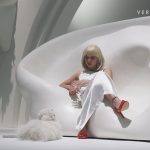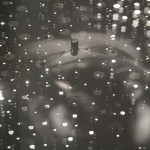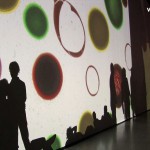Otto Piene: Paths to Paradise at Museum Tinguely in Basel (Switzerland) is an extensive monographic exhibition that emphasizes German artist Otto Piene’s commitment to thinking across media and uniting his practice in its claim of providing what he outlined in 1961 as “paths to paradise.” Otto Piene (1928-2014) was one of the members of the group ZERO, which he founded with Heinz Mack in 1957, with Günther Uecker joining the group in 1961. In 1957, Piene developed the Grid Picture, from 1959 he created the Lichtballette (“Light Ballet”), kinetic installations where light was projected through grids. Otto Piene represented Germany at the Venice Biennale in 1967 and 1971, and exhibited at documenta in Kassel, Germany, in 1959, 1964 and 1977.
The retrospective at Museum Tinguely has its focus on works from the late 1960s and the 1970s, when Piene shifted from Zero to Sky Art and began splitting his time between the US and West Germany. The exhibition includes immersive installations such as Lichtraum mit Mönchengladbachwand, 1963-2013; Anemones: An Air Aquarium, 1976/2023; and The Proliferation of the Sun, 1966/1967. The exhibition has been curated by Dr. Sandra Beate Reimann and Dr. Lauren Elizabeth Hanson and runs until May 12, 2024.
Otto Piene: Paths to Paradise (Wege zum Paradies) / Retrospective at Museum Tinguely, Basel (Switzerland). Vernissage, February 6, 2024.
— Right-click (Mac: ctrl-click) this link to download Quicktime video file.
.
Exhibition text (excerpt):
Otto Piene (1928−2014) aimed high with his art: to shape a more harmonious, peaceful, and sustainable world. His expansive view explored new media and projected aesthetic forms and experiences into new spatial realms. Structured thematically, the monographic exhibition Otto Piene: Paths to Paradise traces his utopian vision as expressed in works from his most significant series and projects in conversation with his lifelong practice of sketching. Together these works reveal Piene’s use of sketching and drawing in both narrow and broad, literal and figurative senses, and provide an expanded definition in connection to a visionary practice that embraced the application of new technology.
Through a transmedial perspective that bridges periods of his practice often viewed as distinct, this presentation offers a complex reading of Piene’s work that includes several immersive installations and rarely seen works. The exhibition invites audiences to rediscover Otto Piene’s oeuvre, beyond a critique of technological naivety or romantic idealism, and thus provides the viewer transformative and imaginatively expansive tools in an increasingly uncertain world.
This monographic exhibition on Otto Piene addresses the artist’s desire to shape a more harmonious, peaceful, and sustainable world according to a utopian vision that expands art beyond the bounds of traditional media and projects it into atmospheric realms. Rather than presenting his oeuvre chronologically, this exhibition offers a rereading of Piene’s art according to multi- and intermedia projects that engage recurring motifs and ideas. Thus, it bridges periods of his practice that have often been viewed as distinct, namely Zero in Düsseldorf (1957—1966) and technology-based Sky Art after his move to the United States in the 1960s.
Presenting rarely-exhibited and long-celebrated works by Piene alongside unpublished materials, Paths to Paradise will be the first large-scale museum exhibition to seriously consider sketching and drawing as related to his painting, sculpture, installation, and media art. Works and projects from his most significant series and thematic experimentations—raster and smoke paintings, kinetic sculptures, light installations, inflatable sculptures and Sky Art, experimentations in television and new media, etc.—will thus exist in conversation with each other and his lifelong practice of sketching. For the scope of our exhibition, the terms “drawing” and “sketching” encourage new interpretations of Piene’s work and offer a more complete grasp of the broad range of his artistic practice.
Understanding the terms sketching and drawing in both narrow and broad senses, we explore how they translate across media for Piene as he drew with smoke and light and animated the sky using his malleable, inflatable forms. Providing a common thread in his oeuvre, Piene’s sketching practice engages both traditional spaces for drawing, i.e., the sketchbook, and new, innovative technologies as he experimented with television broadcasting, slide projectors, and even lasers. Figuratively speaking, “sketching” can also stand for the potential that Piene outlined for his art—the potential to contribute to the development of society, to overcome the separation between art and technology, to deal with ecological problems, and, most importantly, to live in a more peaceful world unified through art.
Structured thematically, the exhibition guides viewers through and across Piene’s creative endeavors during the second half of the 20th century and into the 21st century. Displays that combine sculptures, paintings, drawings, and archival material (photographs, videos, and other documentation) present themes central to his artistic practice across media and creative periods. Paths to Paradise features several rooms that will be filled with inflatables and light projections that invite audiences to experience the spatial and corporeal qualities of his art. Coursing through eleven rooms, the chapters of the exhibition unfold in spaces that vary in density and in atmosphere, ranging from tension-filled, dark black boxes to light-filled, airy spaces. Presentations in white cube spaces alternate with immersive optical, sculptural, and kinetic experiences.
Within these heterogeneous spaces, the exhibition emphasizes Piene’s commitment to thinking across media and uniting his practice in its claim of providing what he outlined in 1961 as “paths to paradise.” Focusing on works from the late 1960s and the 1970s, when Piene shifted from Zero to Sky Art and began splitting his time between the US and West Germany, the exhibition includes formative immersive installations (The Proliferation of the Sun, 1967; Fleurs du Mal, 1969) as well as early experimentation with television and light projection (Black Gate Cologne, 1968; The Medium Is the Medium, 1969; Lichtspur im Haus der Sonne, 1974). Overlooked works and new archival findings (e.g., documentation of an early version of The Proliferation of the Sun) will also be presented for the first time, paired with rarely seen works. Additionally, the exhibition will breathe life back into works that haven’t been shown since their first presentations (e.g., Anemones: An Air Aquarium, Creative Time, 1976; Windsock Sculptures, MIT, 1969−1970) and have never been presented to European audiences. Paths to Paradise will offer a more complex reading of Piene’s work and its contributions to new tendencies in 20th-century art by providing an intermedial perspective. Our curatorial approach underscores how Piene’s groundbreaking strategies of combining art and technology and exploring art’s public, social, and environmental potential remain relevant and compelling to this day.






